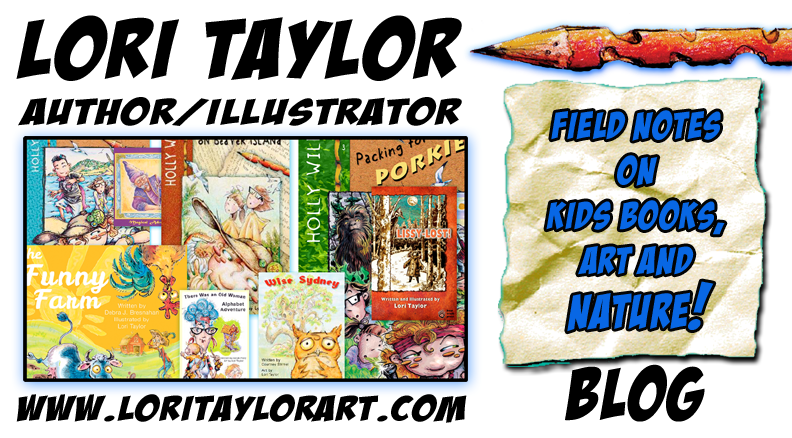
After returning from Canada's Lake Superior Provincial Park I went through my notes and sketches. Whew! I needed a tutorial in note taking. I have always taken field notes and stressed the importance of them in every class I ever taught to young and old!
I later found a Tutorial on line to refresh myself. It discussed the Grinnell (as in Joseph Grinnell, one of the dedicated fathers of our national parks) system of field note taking through Notes and Journal and Species Account and Catalogs. But I was impressed with the simplicity and importance of the simple act of the Field Notes in a Field Notebook. Here is what I gleaned from the article.
Carry a notebook everywhere. That's super. I can do that. My problem was though, I took FOUR notebooks to Canada, actually FIVE if I count the one I carry in my purse. I had sketches and notes scattered everywhere. What can I say, I'm a sucker for a pretty blank book. So I need to limit my sketching to at least TWO when I go out. A small pocket notebook and 8.5 x 11" spiral bound to put those notes in (stapled or glued) and any map, text or travel guide, etc.
STATE, DATE, TIME the Field Note author suggests--(I do the who, what, when, and wheres)I failed to put  dates and times in my Canadian sketches. Maybe I was smitten with the wild Canadian scenery or the thought of being surrounded by wolves in the mist that I forgot this essential data. I added it later to my scanned sketches and realized then that the date was wrong. A matter of a day or two, but this could be bad if it was something of vital importance. So, add DATE, TIME of DAY and weather in your sketch.
dates and times in my Canadian sketches. Maybe I was smitten with the wild Canadian scenery or the thought of being surrounded by wolves in the mist that I forgot this essential data. I added it later to my scanned sketches and realized then that the date was wrong. A matter of a day or two, but this could be bad if it was something of vital importance. So, add DATE, TIME of DAY and weather in your sketch.
 dates and times in my Canadian sketches. Maybe I was smitten with the wild Canadian scenery or the thought of being surrounded by wolves in the mist that I forgot this essential data. I added it later to my scanned sketches and realized then that the date was wrong. A matter of a day or two, but this could be bad if it was something of vital importance. So, add DATE, TIME of DAY and weather in your sketch.
dates and times in my Canadian sketches. Maybe I was smitten with the wild Canadian scenery or the thought of being surrounded by wolves in the mist that I forgot this essential data. I added it later to my scanned sketches and realized then that the date was wrong. A matter of a day or two, but this could be bad if it was something of vital importance. So, add DATE, TIME of DAY and weather in your sketch.
I did quick, quick sketches that caught the moment. "I'm not writing it down to remember it later, I'm writing it down to remember it." was a quote I found online. Later, while looking at photos, you may not catch the moment like you did with a sketch. The lake sketch was a simple and quick contour outline. Without words, it tells the weather. And this was a quick sketch because the drifitng kayak and scene kept moving!
The other sketch of the fallen log shows life and time of day and weather and season by the plants and animal activities. (The log had 4 trees and 1 shrub specie growing out of it) How cool is that? When I see the sketch I am instantly reminded and sent back to that day of the dragonfly laying eggs in the water, the smell of joe-pye weed and the small sparrow foraging on shore and the sound of the kayak bobbing in that cove. HOW COOL IS THAT? All from a sketch.

DRAW WHAT YOU SEE!!! Oh, so important. In the evening resting at a picnic table I noticed "v's" in the water moving across the lake. This sent the camp into a scramble for binocs and cameras! "Beaver!" I shouted. "Otter!" Lisa shouted. "NO! A sea monster!" I corrected myself. What looked like a brown beaver head suddenly turned into THREE lumps on the water. What the heck!
The brown thing(s) swam for the shore and I headed for my journal and spotting scope. I needed bigger guns now to see what crawled out! Marie and Lisa walked/trotted/ran down the shore with camera and binocs. I set up my scope. The mysterious brown beings crawled out onto shore. Two brown lumps--or rather two brown butts climbed over a log and into the brush. I drew what I saw. (*Sketch what you see before consulting a guide book! This will prove your sighting more accurately.)
Afterward, we compared photos (some blurry and the others really, really blurry) and my sketch. Hmm. Beaver or Otter. Then we discussed behavior. Beaver do not roll onto their backs and play. Otters do this. This was the "sea monster" pose that I saw (before I found binocs). I was convinced. Conclusion: Otters x 2.
These sketches become vital for future illustrations, discussions, stories and art. At the time, they are great fun to do. Later, when you reflect upon them you truly see their value. It's time to go get another sketchbook. For more info, Google--Field Notes and Joseph Grinnell.
